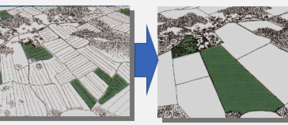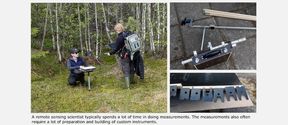A closer look at tree stems
It is rumored that it is the little things that make a big difference. This might also be true for tree bark in remote sensing.

What is the first thing that you see or think of when looking at an aerial or satellite image of a forest? I would be surprised if you said tree stems or bark. The stems are often neglected as our interest can be peaked by more visible elements, such as individual tree crowns, forest stand boundaries, and ground areas without trees. Even though the visibility of the tree stem in the airborne or satellite image is limited or even nonexistent, they are physically still there contributing to the overall forest reflectance. Consequently, understanding the spectral behavior of individual canopy elements is vital in remote sensing of forests because it allows us to interpret satellite and airborne data more accurately. So, if we dare to venture a little further into the less obvious perspectives in remote sensing of forests, a closer look at the optical properties of bark might hold surprisingly many future applications. And a closer look is a lot easier under the tree canopy.
In many forests, the tree stems are often the most feasible canopy component for spectral measurements. It is this accessibility for ground-based optical measurements that make bark spectra particularly interesting. One application that could possibly utilize the spectral signatures of stem bark is the identification of tree species in the forest. Developing novel and accurate methods to identify tree species from ground-based observations could enhance our understanding of biodiversity patterns and support future forest management decisions. And if not, we can still gain valuable information on the spectral variation of stem bark for different tree species, which again helps us to interpret remote sensing data more accurately.
Next time you’re in a forest (hiking, berry picking, or just enjoying some fresh air), see if you can identify a tree by just looking at the stem and its bark. How many different species can you identify? Is it perhaps the color or texture that separates one species from the other? It might be the small details that make the difference.
About the author: Jussi Juola is a doctoral researcher in geoinformatics at Aalto University.
Show other posts from this blog

Länsi-Antarktis on mannerjäätiköiden heikko kohta
Läntisen Etelämantereen jäätiköt ovat avainasemassa siinä, kuinka nopeasti merenpinta alkaa nousta ilmaston lämmetessä.
Development of Finnish agricultural parcel structure 2010-2020: a spatial analysis
Hermanni Hentunen analyzes the temporal development of parcel structure in Finland between the years 2010 and 2020.
What is the value of earth observation data?
With socioeconomic impact assessment it is possible to specify and quantify the impact that earth observation data has on our society.